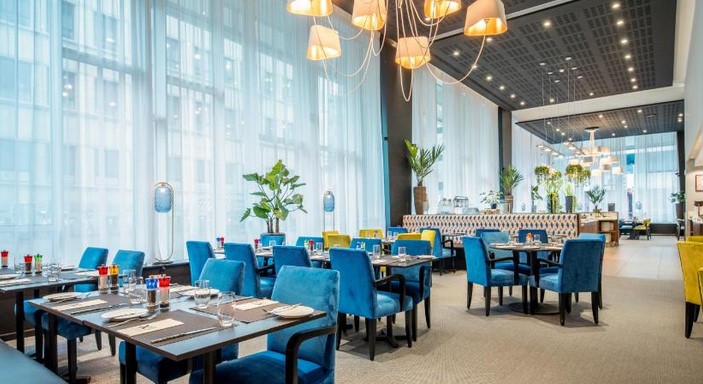Europa Cafeteria: Dining in the Heart of the European Parliament

Source:https://q-xx.bstatic.com
Tucked within the corridors of power and diplomacy in Brussels lies a lesser-known but culturally significant destination: the Europa cafeteria. Located inside the European Parliament complex, this dining venue serves not only as a place to eat but as a symbol of unity, diversity, and efficiency that mirrors the ethos of the European Union itself. For Members of the European Parliament (MEPs), diplomats, journalists, and visitors, the cafeteria offers more than a meal—it provides a snapshot of Europe’s culinary variety and political life, all within a single shared space.
1. A Culinary Crossroads in a Political Hub
The European Parliament, often seen as a place of debate and decision-making, also operates as a microcosm of European society. Nowhere is this more evident than in the Europa cafeteria. Every day, hundreds of people from across the continent pass through its food lines, sit together at its tables, and engage in conversations that span languages, ideologies, and cultural backgrounds.
The menu reflects this multicultural vibrancy. From hearty German schnitzels to Mediterranean salads, French pastries to Eastern European stews, the offerings rotate to represent the various cuisines of EU member states. Special themed weeks are held regularly, featuring traditional dishes from a selected country, allowing staff and visitors alike to experience new tastes and traditions.
This gastronomic diplomacy complements the legislative work being done just meters away. The idea is simple: shared meals encourage shared understanding. When parliamentarians and staff eat together, they also build relationships that extend beyond official negotiations. Over coffee and regional specialties, alliances are formed, and perspectives are broadened.
Subheading: Behind the Scenes – Logistics and Sustainability
Running a cafeteria that serves hundreds of diverse meals daily in a highly secure and bureaucratic environment is no small feat. The Europa cafeteria is operated by a dedicated catering team that manages not only variety and nutrition but also sustainability and food sourcing.
Procurement focuses heavily on organic, seasonal, and local produce. Much of the meat and dairy used comes from European farms that meet strict animal welfare and environmental standards. Vegan and vegetarian options are standard—not exceptions—ensuring that dietary needs and environmental concerns are considered.
The cafeteria has also introduced a waste-reduction initiative in line with the European Green Deal goals. Single-use plastics have been phased out, food waste is carefully monitored, and composting and recycling are the norm. Digital ordering systems and cashless payments streamline operations while reducing the facility’s carbon footprint.
In addition, the architecture and layout of the cafeteria support its broader mission. Designed with open spaces, natural lighting, and communal seating, the venue encourages interaction. It’s common to see policymakers sitting beside interns or visiting university groups, all eating together in a democratic and relaxed environment.
2. Who Dines at Europa Cafeteria—and Why It Matters
While it may seem like just another institutional eatery, the Europa cafeteria plays an important role in the ecosystem of European politics. The clientele ranges from elected officials to interpreters, researchers, journalists, and civil servants. Each meal served helps sustain the individuals shaping policies that affect over 400 million citizens.
More importantly, the cafeteria serves as an informal extension of the Parliament itself. Policy ideas are discussed casually over meals, and spontaneous meetings can occur without formal scheduling. The mix of people and perspectives found here often leads to innovative problem-solving and stronger cross-national cooperation.
Occasionally, the Europa cafeteria even becomes a venue for informal diplomacy. During particularly tense legislative sessions or international summits, the relaxed environment of the dining hall can be a welcome respite—a place where heated discussions cool into civil dialogue over shared desserts or coffee.
There are also cultural programming events hosted in the cafeteria space, including food fairs, small exhibitions, and performances. These are strategically designed to foster greater understanding and appreciation of Europe’s rich heritage.
3. Visiting the Cafeteria: Access and Experience
Access to the Europa cafeteria is generally limited to those with credentials for the European Parliament, including MEPs, accredited assistants, journalists, staff members, and registered visitors. However, on certain open days and educational tours, the public may be granted a glimpse into this unique space.
For those fortunate enough to dine at the Europa cafeteria, the experience is both practical and symbolic. Meals are affordably priced, portions are generous, and service is efficient. But beyond the logistics, what stands out most is the environment—polished yet unpretentious, communal yet secure, diverse yet unified.
Dining at the cafeteria allows one to observe the rhythm of European governance at a human scale. Laughter echoes across tables, quick meetings happen between bites, and multilingual conversations flow as freely as the coffee. In many ways, it is the heartbeat of the institution—where policy meets personality.
In a building dedicated to negotiation and lawmaking, the Europa cafeteria offers a more personal dimension of European cooperation. Through shared meals, sustainable practices, and cultural inclusion, the cafeteria embodies the EU’s core values of unity in diversity. Whether you’re a policymaker shaping directives or a visitor passing through on a tour, the cafeteria provides a taste—not only of Europe’s cuisine—but of its cooperative spirit. As the EU continues to evolve, its dining hall remains a steadfast reminder that sometimes, the most meaningful diplomacy begins with a shared meal.





